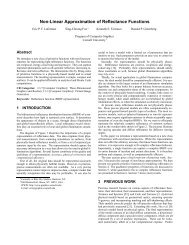pigmented colorants: dependence on media and time - Cornell ...
pigmented colorants: dependence on media and time - Cornell ...
pigmented colorants: dependence on media and time - Cornell ...
You also want an ePaper? Increase the reach of your titles
YUMPU automatically turns print PDFs into web optimized ePapers that Google loves.
ials.<br />
In additi<strong>on</strong>, we presented a physically based model to interactively simulate<br />
the appearance of <str<strong>on</strong>g>pigmented</str<strong>on</strong>g> <str<strong>on</strong>g>colorants</str<strong>on</strong>g> using Kubelka Munk theory <strong>and</strong> modern<br />
graphics hardware. The spectral data is c<strong>on</strong>verted into Kubelka Munk absorpti<strong>on</strong><br />
<strong>and</strong> scattering coefficients. As a result, arbitrary mixtures of pigments that we<br />
have not measured can be simulated. Further, since our data also spans <strong>time</strong>, the<br />
simulated appearance of these mixtures can be viewed at any point in <strong>time</strong>.<br />
In our system, other global c<strong>on</strong>diti<strong>on</strong>s can also be modified in real <strong>time</strong>. A<br />
user can instantaneously change the binding <strong>media</strong> in which the pigments are<br />
suspended–<strong>on</strong>e can simulate the appearance of a work as if were d<strong>on</strong>e in oil or<br />
acrylic or another <strong>media</strong>. Since we compute the lighting calculati<strong>on</strong>s from spectra,<br />
the simulated painting can be re-lit under a number of different illuminants, such<br />
as daylight or fluorescent light.<br />
The previous chapter discusses applicati<strong>on</strong>s for use of this system for the artist<br />
or art historian. Artists that are more aware of their materials will be able to pre-<br />
dict how a color will appear after some <strong>time</strong> <strong>and</strong> make adjustments that suit their<br />
creative visi<strong>on</strong>. Restorati<strong>on</strong>ists who underst<strong>and</strong> how a color’s underlying materials<br />
change can visualize how an artwork looked in its original brilliance. C<strong>on</strong>serva-<br />
ti<strong>on</strong>ists can predict how l<strong>on</strong>g a work can be displayed under natural c<strong>on</strong>diti<strong>on</strong>s<br />
before perceptual changes are evident.<br />
Our work has implicati<strong>on</strong>s in many other industries that utilize <str<strong>on</strong>g>pigmented</str<strong>on</strong>g><br />
<str<strong>on</strong>g>colorants</str<strong>on</strong>g>. Currently, digital printing inks use primarily dye based inks. Due<br />
to the popularity of digital photography, many individuals are printing <strong>on</strong> high<br />
quality paper <strong>and</strong> canvas <strong>and</strong> framing the pieces. However, dye based inks have a<br />
197<br />
l<strong>on</strong>gevity of <strong>on</strong>ly a few years before serious fading occurs. As a result, <str<strong>on</strong>g>pigmented</str<strong>on</strong>g>



